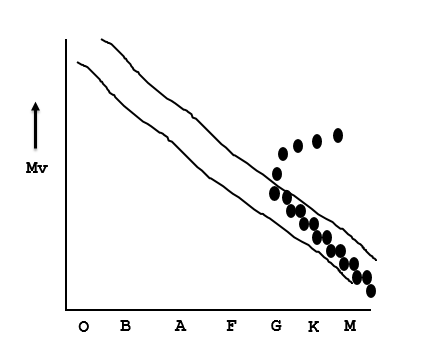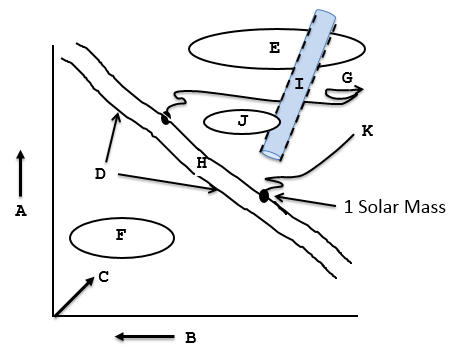Correct Answer

verified
1 Cepheid ...View Answer
Show Answer
Correct Answer
verified
View Answer
Multiple Choice
The fusion of helium into carbon will take a temperature of at least
A) 5 million degrees Kelvin
B) 10 million degrees Kelvin
C) 50 million degrees Kelvin
D) 100 million degrees Kelvin
E) 600 million degrees Kelvin
Correct Answer

verified
Correct Answer
verified
True/False
The helium flash stage will always completely destroy a star and any planets nearby it
Correct Answer

verified
Correct Answer
verified
Short Answer
As a main sequence star evolves off the main sequence, the helium core is contracting while the outer envelope is _______________.
Correct Answer

verified
Correct Answer
verified
Multiple Choice
Observing star clusters will give astronomers needed data for stellar evolution because all the stars in the cluster have the same ____.
A) masses
B) temperatures
C) ages
D) luminosities
E) apparent magnitudes
Correct Answer

verified
Correct Answer
verified
True/False
Observing star clusters will give astronomers needed data for stellar evolution because all the stars are the same age.
Correct Answer

verified
Correct Answer
verified
Essay
Briefly explain why there is a main sequence on the H-R Diagram.
Correct Answer

verified
Models of stars show that there is a mai...View Answer
Show Answer
Correct Answer
verified
View Answer
True/False
The age of a star cluster can be approximated by finding its turnoff point in the distribution of data points that represent stars on the H-R Diagram.
Correct Answer

verified
Correct Answer
verified
Essay
Why is there an upper end in the main sequence of the H-R diagram?
Correct Answer

verified
The upper end in the main sequence of th...View Answer
Show Answer
Correct Answer
verified
View Answer
Multiple Choice
Because of the period-luminosity relation for Cepheids and RR Lyrae variable stars, astronomers are able to _____
A) determine the relationship between the period of pulses and luminosity
B) measure the mass of a star
C) calculate a star's diameter
D) determine the chemical composition of a Type I Cepheid
E) narrow their study to eclipsing binary stars only
Correct Answer

verified
Correct Answer
verified
Multiple Choice
As a one-solar-mass star evolves off the main sequence, it will probably undergo a _____.
A) nova burnout
B) helium flash
C) hydrogen flash
D) helium bang
E) carbon flash
Correct Answer

verified
Correct Answer
verified
Multiple Choice
Globular clusters have approximately how many stars?
A) 100,000 - 1,000,000
B) 10,000 - 90,000
C) 5,000 - 10,000
D) 1000 - 5000
E) less than 1000
Correct Answer

verified
Correct Answer
verified
Short Answer
The lower limit for a main sequence star is _______________ solar masses.
Correct Answer

verified
Correct Answer
verified
Short Answer
The Instability Strip on the H-R Diagram is the location for what type of stars _______________.
Correct Answer

verified
Cepheid variables,RR...View Answer
Show Answer
Correct Answer
verified
View Answer
True/False
Astronomers determine the internal structure of a star by using stellar models, since they cannot "see" into the interior of a star.
Correct Answer

verified
Correct Answer
verified
Multiple Choice
 Figure: Main-Sequence Stars
What is the approximate age of the star cluster in the accompanying figure?
Figure: Main-Sequence Stars
What is the approximate age of the star cluster in the accompanying figure?
A) 10 million years
B) 100 million years
C) 10 billion years
D) 100 billion years
E) Cannot be determine from the given data.
Correct Answer

verified
Correct Answer
verified
Multiple Choice
What is the upper limit of a brown dwarf's size?
A) no upper limit
B) 0.50 solar masses
C) 0.10 solar masses
D) 0.08 solar masses
E) less than 0.08 solar masses
Correct Answer

verified
Correct Answer
verified
Multiple Choice
Cepheid and RR Lyrae variable stars change their brightness by ____.
A) atmospheric explosions of hydrogen gas
B) internal changes in their fusion processes
C) a combination of atmospheric explosions and internal changes
D) a combination of atmospheric explosions and physically pulsating
E) changing its period between pulses
Correct Answer

verified
Correct Answer
verified
True/False
The energy emitted from the surface of a main sequence star is less than the energy generated in the core.
Correct Answer

verified
Correct Answer
verified
Matching
 Match the following list of events or labels to the location on the figure. The figure represents the post-main-sequence phase of a large mass star (upper curve) and a low mass star (lower curve). Use one letter for each question. "A", "B", and "C" are the axes of the diagram.
Match the following list of events or labels to the location on the figure. The figure represents the post-main-sequence phase of a large mass star (upper curve) and a low mass star (lower curve). Use one letter for each question. "A", "B", and "C" are the axes of the diagram.
Correct Answer
Showing 21 - 40 of 51
Related Exams